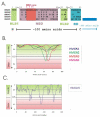Regulation of chromatin structure and function by HMGN proteins
- PMID: 19948260
- PMCID: PMC2818575
- DOI: 10.1016/j.bbagrm.2009.11.016
Regulation of chromatin structure and function by HMGN proteins
Abstract
High mobility group nucleosome-binding (HMGN) proteins are architectural non-histone chromosomal proteins that bind to nucleosomes and modulate the structure and function of chromatin. The interaction of HMGN proteins with nucleosomes is dynamic and the proteins compete with the linker histone H1 chromatin-binding sites. HMGNs reduce the H1-mediated compaction of the chromatin fiber and facilitate the targeting of regulatory factors to chromatin. They modulate the cellular epigenetic profile, affect gene expression and impact the biological processes such as development and the cellular response to environmental and hormonal signals. Here we review the role of HMGN in chromatin structure, the link between HMGN proteins and histone modifications, and discuss the consequence of this link on nuclear processes and cellular phenotype.
Published by Elsevier B.V.
Figures


References
-
- Bustin M, Reeves R. High-mobility-group chromosomal proteins: architectural components that facilitate chromatin function. Prog Nucleic Acid Res Mol Biol. 1996;54:35–100. - PubMed
-
- Bustin M. Chromatin unfolding and activation by HMGN(*) chromosomal proteins. Trends Biochem Sci. 2001;26:431–437. - PubMed
-
- West KL, Postnikov YV, Birger Y, Bustin M. Chromatin decompaction method by HMGN proteins. Methods Enzymol. 2003;371:521–536. - PubMed
Publication types
MeSH terms
Substances
Grants and funding
LinkOut - more resources
Full Text Sources

